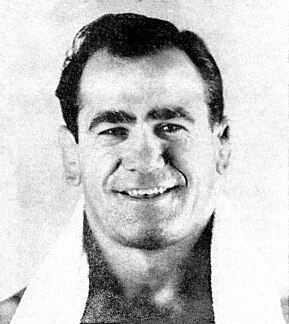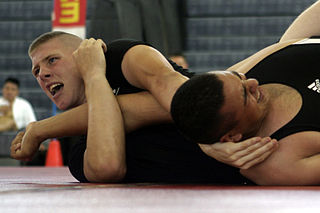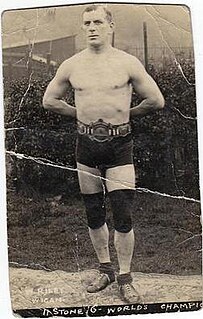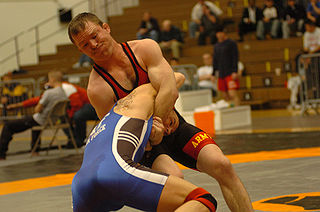
Frank Alvin Gotch was an American professional wrestler.

Georg Karl Julius Hackenschmidt was an early 20th-century Estonian strongman, professional wrestler, author, and sports philosopher who is recognized as professional wrestling's first world heavyweight champion.

Aloysius Martin "Lou" Thesz was an American professional wrestler. A twentysix-time world champion, he held the NWA World Heavyweight Championship three times for a combined total of 10 years, three months and nine days – longer than anyone else in history. Thesz is widely regarded as one of the greatest wrestlers of all time. In Japan, Thesz was known as a 'God of Wrestling' and was called Tetsujin, which means 'Ironman', in respect for his speed, conditioning and expertise in catch wrestling. In addition to being a member of its inaugural class, he helped establish the George Tragos/Lou Thesz Professional Wrestling Hall of Fame and is a charter member of several other halls of fame, including: WCW, Wrestling Observer Newsletter, Professional Wrestling and WWE's Legacy Wing.

Submission wrestling or combat wrestling, is a form of competition and a general term for martial arts and combat sports that focus on clinch and ground fighting with the aim of obtaining a submission through the use of submission holds. The term "submission wrestling" usually refers only to the form of competition and training that does not use a gi, or "combat kimono", of the sort often worn with belts that establish rank by color, though some may use the loose trousers of such a uniform, without the jacket. Not using a gi has a major impact on the sport : there are many choke techniques which make use of the lapels of the gi, thus rendering them un-useable and grappling in general becomes more difficult when the opponent doesn't have a gi to grab hold of.

Wrestling is a combat sport involving grappling-type techniques such as clinch fighting, throws and takedowns, joint locks, pins and other grappling holds. The sport can either be theatrical for entertainment, or genuinely competitive. A wrestling bout is a physical competition, between two competitors or sparring partners, who attempt to gain and maintain a superior position. There are a wide range of styles with varying rules with both traditional historic and modern styles. Wrestling techniques have been incorporated into other martial arts as well as military hand-to-hand combat systems.

Jan Stanisław Cyganiewicz, better known by the ring name Stanislaus Zbyszko, was a Polish strongman and professional wrestler — a two-time World Heavyweight Champion at his highest profile in the United States during the 1920s. The surname Zbyszko was only a nickname, which was given him by friends due to his bravery when he was a child; it was the name of a fictional medieval Polish knight from the historical novel The Knights of the Cross by Henryk Sienkiewicz. He was the brother of Wladek Zbyszko.

A combat sport, or fighting sport, is a competitive contact sport that usually involves one-on-one combat. In many combat sports, a contestant wins by scoring more points than the opponent or by disabling the opponent. Common combat sports include mixed martial arts, boxing, wrestling, judo, fencing, savate, kickboxing, Muay Thai, Sanda, Tae Kwon Do, Capoeira, Brazilian Jiu-jitsu, HMB, Sambo, Sumo, Kyokushin, and Kūdō.
Shoot wrestling is a combat sport that has its origins in Japan's professional wrestling circuit of the 1970s. Professional wrestlers of that era attempted to use more realistic or even "full contact" moves in their matches to increase their excitement. The name "shoot wrestling" comes from the professional wrestling term "shoot", which refers to any unscripted occurrence within a scripted wrestling event. Prior to the emergence of the current sport of shoot wrestling, the term was commonly used in the professional wrestling business, particularly in the United Kingdom, as a synonym for the sport of catch wrestling. Shoot wrestling can be used to describe a range of hybrid fighting systems such as shootfighting, shoot boxing and the styles of mixed martial arts done in the Shooto, Pancrase and RINGS promotions.

Daniel DeWayne Severn, nicknamed "The Beast", is an American semi-retired mixed martial artist, amateur and professional wrestler and occasional actor. A UFC Hall of Fame member, Severn is considered one of the leading pioneers of mixed martial arts and the first true world-class wrestler to compete in the Ultimate Fighting Championship. He is best known for his success in the early years of the UFC where he became the first and only UFC Triple Crown champion and the only man to win a world title and a tournament, having won the UFC Superfight Championship and the 1995 Ultimate Ultimate tournament. Severn has also competed in King of the Cage, PRIDE FC, Cage Rage, WEC, RINGS and MFC, and holds a professional MMA Record of 101–19–7.

Charles Istaz was a Belgian-born German professional wrestler and trainer, best known by his ring name Karl Gotch. In Japan, Gotch was known as the "God of Wrestling" due to his influence in shaping the Japanese professional wrestling style.
Adolph Ernst, better known for his ring name Ad Santel, was a German-born American professional wrestler, considered one of the greatest practitioners of catch wrestling ever. He is also considered to be one of the first mixed martial artists of the modern era due to his feud with the Kodokan judo school.

Catch wrestling is a classical hybrid grappling style and combat sport. It was developed by J. G. Chambers in Britain circa 1870. It was popularized by wrestlers of travelling funfairs who developed their own submission holds, or "hooks", into their wrestling to increase their effectiveness against their opponents. Catch wrestling derives from various different international styles of wrestling: several English styles, Indian pehlwani, and Irish collar-and-elbow wrestling. The training of some modern submission wrestlers, professional wrestlers and mixed martial artists is founded in catch wrestling.

William Alfred “Billy” Robinson was a British professional wrestler, author and catch wrestling instructor. Robinson was well known in Japan where he trained mixed martial arts fighters in catch wrestling. Robinson was one of the few wrestlers who was successful in several continents, winning titles in promotions nearly everywhere he wrestled.

A folk wrestling style is any traditional style of wrestling, which may or may not be codified as a modern sport. Most cultures have developed regional forms of grappling.

Billy Riley was an English practitioner and teacher of catch wrestling. As a trainer in the sport, Riley taught some of the leading post-World War II figures in catch wrestling at his training school called "The Snake Pit" in Wigan, Greater Manchester, England.
A Snake pit is a place of horror, torture and even death in European legends and fairy tales.
The history of professional wrestling, as a performing art, started in the early 20th century, with predecessors in funfair and variety strongman and wrestling performances in the 19th century.

Wrestling and grappling sports have a long and complicated history, stretching into prehistoric times. Many traditional forms survive, grouped under the term folk wrestling. More formal systems have been codified in various forms of martial arts worldwide, where grappling techniques form a significant subset of unarmed fighting.

Mark Cocker is a Freestyle wrestler, Ju-Jitsu and Judo player who trains with Bolton Olympic Wrestling Club. Cocker is a British and English freestyle wrestling champion and has competed for England and Great Britain for fifteen years. He is also a 1st Dan black belt in Judo under Steve Pullen MBE and 1st Dan Black Belt in Ju-Jitsu under Professor Trevor Roberts.

The various styles of wrestling include: